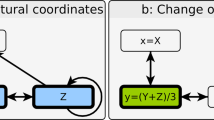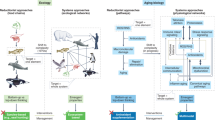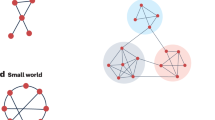Abstract
Good health, which reflects the harmonious integration of molecules, cells, tissues and organs, is dynamically stable: when displaced by disease, compensation and correction are common, even without medical care. Physiology and computational biology now suggest that healthy dynamic stability arises through the combination of specific feedback mechanisms and spontaneous properties of interconnected networks. Today's physicians are already testing to 'see if the network is right'; tomorrow's physicians may well use therapies to 'make the network right'.
This is a preview of subscription content, access via your institution
Access options
Subscribe to this journal
Receive 51 print issues and online access
$199.00 per year
only $3.90 per issue
Buy this article
- Purchase on Springer Link
- Instant access to full article PDF
Prices may be subject to local taxes which are calculated during checkout


Similar content being viewed by others
References
Chambers, N. K. & Buchman, T. G. Shock at the millennium. I. Walter B. Cannon and Alfred Blalock. Shock 13, 497–504 (2000).
Chambers, N. K. & Buchman, T. G. Shock at the millennium II. Walter B. Cannon and Lawrence J. Henderson. Shock 16, 278–284 (2001).
Wolkenhauer, O. Systems biology: the reincarnation of systems theory applied in biology? Brief Bioinform. 2, 258–270 (2001).
Kauffman, S. A. The Origins of Order: Self-Organization and Selection in Evolution (Oxford Univ. Press, Oxford, 1993).
Chauvet, G. A. Hierarchical functional organization of formal biological systems: a dynamical approach. I. The increase of complexity by self-association increases the domain of stability of a biological system. Phil. Trans. R. Soc. Lond. B 339, 425–444 (1993).
Kitano, H. in Foundations of Systems Biology (ed. Kitano, H.) 1–36 (MIT Press, Cambridge, MA, 2001).
Kitano, H. Systems biology: a brief overview. Science 295, 1662–1664 (2002).
Hartl, F. U. & Hayer-Hartl, M. Molecular chaperones in the cytosol: from nascent chain to folded protein. Science 295, 1852–1858 (2002).
Levy, B. D., Clish, C. B., Schmidt, B., Gronert, K. & Serhan, C. Lipid mediator class switching during acute inflammation: signals in resolution. Nature Immunol. 2, 612–619 (2001).
Matzinger, P. The danger model: a renewed sense of self. Science 296, 301–305 (2002).
DeMeester, S. L., Buchman, T. G. & Cobb, J. P. The heat shock paradox: does NF-κB determine cell fate? FASEB J. 15, 270–274 (2001).
Bernik, T. R. et al. Pharmacological stimulation of the anti-inflammatory pathway. J. Exp. Med. 195, 781–788 (2002).
Blalock, J. E. Harnessing a neural-immune circuit to control inflammation and shock. J. Exp. Med. 195, F25–F28 (2002).
Weiss, Y. G., Maloyan, A., Tazelaar, J., Raj N. & Deutschman, C. S. Adenoviral transfer of HSP-70 into pulmonary epithelium ameliorates experimental acute respiratory distress syndrome. J. Clin. Invest. 110, 801–806 (2002).
Slutsky, A. S. Hot new therapy for sepsis and the acute respiratory distress syndrome. J. Clin. Invest. 110, 737–739 (2002).
Marshall, J. C. Inflammation, coagulopathy, and the pathogenesis of multiple organ dysfunction syndrome. Crit. Care Med. 29 (Suppl.), S99–S106 (2001).
Seely, A. J. & Christou, N. V. Multiple organ dysfunction syndrome: exploring the paradigm of complex nonlinear systems. Crit. Care Med. 28, 2193–2200 (2000).
Pincus, S. M. Greater signal regularity may indicate increased system isolation. Math. Biosci. 122, 161–181 (1994).
Godin, P. J. & Buchman, T. G. Uncoupling of biological oscillators: a complementary hypothesis concerning the pathogenesis of multiple organ dysfunction syndrome. Crit. Care Med. 24, 1107–1116 (1996).
Godin, P. J. et al. Experimental human endotoxemia increases cardiac regularity: results from a prospective, randomized, crossover trial. Crit. Care Med. 24, 1117–1124 (1996).
Ellenby, M. S. et al. Uncoupling and recoupling of autonomic regulation of the heart beat in pediatric septic shock. Shock 16, 274–277 (2001).
Goldstein, B., Toweill, D., Lai, S., Sonnenthal, K. & Kimberly, B. Uncoupling of the autonomic and cardiovascular systems in acute brain injury. Am. J. Physiol. 275, R1287–R1292 (1998).
Goldberger, A. L. et al. Fractal dynamics in physiology: alterations with disease and aging. Proc. Natl Acad. Sci. USA 99, 2466–2472 (2002).
Pincus, S. M. Approximate entropy as a measure of system complexity. Proc. Natl Acad. Sci. USA 88, 2297–2301 (1991).
Pincus, S. M. et al. Older males secrete luteinizing hormone (LH) and testosterone more irregularly, and jointly more asynchronously, than younger males. Proc. Natl Acad. Sci. USA 93, 14100–14105 (1996).
Schäfer, C., Rosenblum M. G., Abel, H.-H & Kurths, J. Synchronization in human cardiorespiratory system. Phys. Rev. E 60, 657–870 (1999).
Ito, J. & Kaneko, K. Spontaneous structure formation in a network of chaotic units with variable connection strengths. Phys. Rev. Lett. 88, 028701-1–028701-4 (2002).
Noble, D. The rise of computational biology. Nature Rev. Mol. Cell Biol. 3, 460–462 (2002).
Noble, D. Modeling the heart—from genes to cells to the whole organ. Science 295, 1678–1682 (2002).
Fink, C. C. et al. An image-based model of calcium waves in differentiated neuroblastoma cells. Biophys. J. 79, 163–183 (2000).
Collins, J. J., Chow, C. C., Imhoff, T. T. Aperiodic stochastic resonance in excitable systems. Phys. Rev. E 52, R3321–R3324 (1995).
Suki, B. et al. Life-support system benefits from noise. Nature 393, 127–128 (1998).
Neiman, A., Schimansky-Geier, L., Moss, F., Shulgin, B. & Collins, J. J. Synchronization of noisy systems by stochastic signals. Phys Rev E 60, 284–292 (1999).
Gong, Y., Matthews, N. & Qian, N. Model for stochastic-resonance-type behavior in sensory perception. Phys. Rev. E 65, 031904-1–031904-5 (2002).
Lipsitz, L. A. & Goldberger, A. L. Loss of 'complexity' and aging. Potential applications of fractals and chaos theory to senescence. J. Am. Med. Assoc. 267, 1806–1809 (1992).
Schafer, C., Rosenblum, M. G., Kurths, J. & Abel, H. H. Heartbeat synchronized with ventilation. Nature 392, 239–240 (1998).
Veldhuis, J. D., Iranmanesh, A., Mulligan, T. & Pincus, S. M. Disruption of the young-adult synchrony between luteinizing hormone release and oscillations in follicle-stimulating hormone, prolactin, and nocturnal penile tumescence (NPT) in healthy older men. J. Clin. Endocrinol. Metab. 84, 3498–3505 (1999).
Jeong, H., Tombor, B., Albert, R., Oltvai, Z. N. & Barabasi, A. L. The large-scale organization of metabolic networks. Nature 407, 651–654 (2000).
Albert, R., Jeong, H. & Barabasi, A. L. Error and attack tolerance of complex networks. Nature 406, 378–382 (2000).
Acknowledgements
Work in the author's laboratory is supported by the National Institute of General Medical Sciences and the National Institute of Nursing Research. T.G.B. thanks the following colleagues for their comments during preparation and review of this article: N. Chambers, P. Cobb, J. Collins, W. Fontana, B. Goldstein, K. Kaneko, H. Kitano, D. Noble, S. Pincus and K. Tracey.
Author information
Authors and Affiliations
Corresponding author
Rights and permissions
About this article
Cite this article
Buchman, T. The community of the self. Nature 420, 246–251 (2002). https://doi.org/10.1038/nature01260
Issue Date:
DOI: https://doi.org/10.1038/nature01260
This article is cited by
-
Suitability of multiscale entropy for complexity quantification of cardiac rhythms in chronic pathological conditions: a similarity patterns based investigation
Multimedia Tools and Applications (2021)
-
Development and validation of a sample entropy-based method to identify complex patient-ventilator interactions during mechanical ventilation
Scientific Reports (2020)
-
Genetic and epigenetic Muller’s ratchet as a mechanism of frailty and morbidity during aging: a demographic genetic model
Human Genetics (2020)
-
Organ system network analysis and biological stability in critically ill patients
Critical Care (2019)
-
Heart rate elevations during early sepsis predict death in fluid-resuscitated rats with fecal peritonitis
Intensive Care Medicine Experimental (2018)
Comments
By submitting a comment you agree to abide by our Terms and Community Guidelines. If you find something abusive or that does not comply with our terms or guidelines please flag it as inappropriate.



